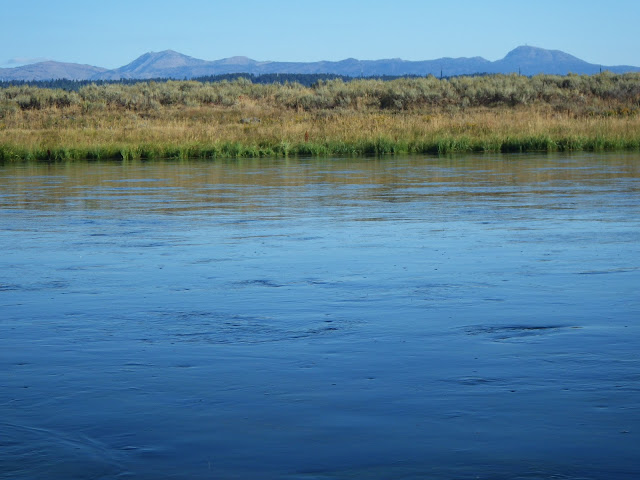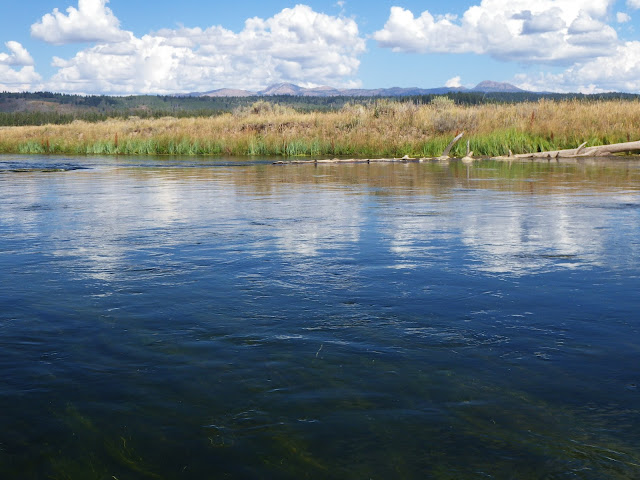I Have the Upper Ranch all to Myself!
Tricos are Still in the House
The Last Chance Cripple-My Fly of the Season
Henry’s Fork-The Star in the Center.
From most places on the Railroad Ranch section, I can see my
place in the grand scheme of important things.
Looking south, the earth’s crust just drops off and goes away, down into
the immense Snake River Valley of southeast Idaho.
The South Fork of the Snake, from western Wyoming, joins the Henry’s for a hazardous
journey to the pacific. The forest of
the raised Island
Park caldera stretches to
an empty horizon.
To the east though, I see the Grand Tetons rising skyward, and
envision Jackson Lake and the Snake River Valley
just on their other side, birth place of the South Fork. Afternoon sun shines brightly from the peaks,
but they stand quietly in the morning sun. To the northeast, the wooded plateau of Yellowstone Park
looms large. I picture the valleys,
wildlife, and geysers. It’s often cloudy
in that direction.
Looking north 20 or so miles across the wooded caldera, West Yellowstone is over the first hill to the right, and Henry’s lake slightly to the left. The lower Madison River flows just over the small hill beyond Henrys Lake, to the left. Go north and take the fork at the road.
Looking north 20 or so miles across the wooded caldera, West Yellowstone is over the first hill to the right, and Henry’s lake slightly to the left. The lower Madison River flows just over the small hill beyond Henrys Lake, to the left. Go north and take the fork at the road.
To the northwest, Sawtelle
Peak marks the south side of Henry’s Lake, the birth place of this hallowed trout river, and a
great fishery itself. The peak gets
snowed on in June and September, signaling cool nights on the river.
When I look west, I know that just beyond the sparse hills
of Kilgore is the highway to Dillon and the Beaverhead River,
as close as the Tetons to the east.
So the Henry’s Fork, and Last Chance, Idaho, are perfectly planted right in
between all these great places, the star in the center of a fly fishing universe.
On the river, I watch the infant clouds form into cotton
balls directly overhead, the weather of the moment drifting in, and the clouds
with dark bottoms. All appear closer because the elevated volcanic caldera puts
me closer to them. The volcanic rocks
along the river and across Island Park have that Swiss cheese look, and I know
the whole damn place could blow at any moment, but probably won’t.
The rivers waters flow beautifully flat, full of weeds, and
full of bugs that trout love to eat. That
alone makes it a fly fisherman’s paradise.
The water goes from moving at a fast walk at Last Chance, to hardly
moving on the lower Ranch. Upstream is a
canyon with rocks and riffles.
Downstream is fast water and great water falls. No riffles to speak of
interrupt the Ranch flow. Weed patches
break the surface. A rock or log jam
creates “character” in a stretch. Fish
feed at any current break. Fish feed on some
of the banks when they’re not trampled.
I seldom see sub-surface fishermen here, and never see bobbers on fly
leaders. The Ranch is a fly fishing only
stretch. Most everyone is casting dry
flies to visible rising trout. I like
that.
This “bug factory” usually has dependable daily hatches, and
usually more than one kind of bug. The
trout like that. Larger fish require
good casting and fishing skills, but are not overly tough like small spring
creeks. I get in casting range, make a
few casts, and catch most rising trout, or at least get them to eat my
fly. Sometimes I hook them. Often times after hooked, they go into the
thick weeds and deposit my fly there. Or,
they just break it off. All is still
well in the center of the universe.
There’s another head of a large fish, eating something that I’ll try and
figure out, or just tie on the beetle!
I’m forever drawn here because it’s really the birthplace of
my real fly fishing career/passion/hobby/whatever-you-call-it. It is here in the early 80’s that I learned
what a dead drift really was. Dead Drift
U. is what we called it. Multiple
currents pulling at my leader and fly from every which way, and the fly still
has to float “naturally” over the trout if I am to get a bite. That natural drift changes every few inches
as the fly floats down stream. If I can
get a good drift here, I can get one anywhere.
Whenever I cast, I thank the Henry’s Fork.
It is here I caught my first “big” trout on dry flies, feisty
rainbows from 16-22 inches long that always pulled back. For a few summers, the opening day of June 15
marked the beginning of a summer of fly fishing for me. The kickoff planned and anticipated for 10
months. A couple times I was gone all
summer.
Henry’s Fork is the first spring creek I ever fished, though
to some, it’s not a strict spring creek, but a combination of a tail water and
spring creek. The rich water flowing from
Henrys Lake is spring fed and spring-like. Big Springs is as spring-fed as you get. Those two together, with their little friend
the Buffalo Spring Creek, form this great river. A trout river could not have a better mother
and father! No wonder it’s the star.




































